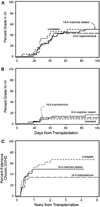Comparison of outcomes of HLA-matched related, unrelated, or HLA-haploidentical related hematopoietic cell transplantation following nonmyeloablative conditioning for relapsed or refractory Hodgkin lymphoma
- PMID: 18940683
- PMCID: PMC2647369
- DOI: 10.1016/j.bbmt.2008.08.014
Comparison of outcomes of HLA-matched related, unrelated, or HLA-haploidentical related hematopoietic cell transplantation following nonmyeloablative conditioning for relapsed or refractory Hodgkin lymphoma
Abstract
We compared the outcome of nonmyeloablative allogeneic hematopoietic cell transplantation (HCT) for patients with relapsed or refractory Hodgkin lymphoma (HL) based on donor cell source. Ninety patients with HL were treated with nonmyeloablative conditioning followed by HCT from HLA-matched related, n=38, unrelated, n=24, or HLA-haploidentical related, n=28 donors. Patients were heavily pretreated with a median of 5 regimens and most patients had failed autologous HCT (92%) and local radiation therapy (83%). With a median follow-up of 25 months, 2-year overall survivals, progression-free survivals (OS)/(PFS), and incidences of relapsed/progressive disease were 53%, 23%, and 56% (HLA-matched related), 58%, 29%, and 63% (unrelated), and 58%, 51%, and 40% (HLA-haploidentical related), respectively. Nonrelapse mortality (NRM) was significantly lower for HLA-haploidentical related (P=.02) recipients compared to HLA-matched related recipients. There were also significantly decreased risks of relapse for HLA-haploidentical related recipients compared to HLA-matched related (P=.01) and unrelated (P=.03) recipients. The incidences of acute grades III-IV and extensive chronic graft-versus-host disease (aGVHD, cGVHD) were 16%/50% (HLA-matched related), 8%/63% (unrelated), and 11%/35% (HLA-haploidentical related). These data suggested that salvage allogeneic HCT using nonmyeloablative conditioning provided antitumor activity in patients with advanced HL; however, disease relapse/progression continued to be major problems. Importantly, alternative donor stem cell sources are a viable option.
Figures
References
-
- Avivi I, Goldstone AH. Autologous stem cell transplantation in Hodgkin’s disease (review) Ann Oncol. 2002;13 Suppl. 1:122–127. - PubMed
-
- Horning SJ, Chao NJ, Negrin RS, et al. High-dose therapy and autologous hematopoietic progenitor cell transplantation for recurrent or refractory Hodgkin’s disease: analysis of the Stanford University results and prognostic indices. Blood. 1997;89:801–813. - PubMed
-
- Lazarus HM, Loberiza FR, Jr, Zhang M-J, et al. Autotransplants for Hodgkin’s disease in first relapse or second remission: a report from the Autologous Blood and Marrow Transplant Registry (ABMTR) Bone Marrow Transplant. 2001;27:387–396. - PubMed
-
- Lazarus HM, Rowlings PA, Zhang MJ, et al. Autotransplants for Hodgkin’s disease in patients never achieving remission: a report from the Autologous Blood and Marrow Transplant Registry. J Clin Oncol. 1999;17:534–545. - PubMed
-
- Tsai T, Goodman S, Saez R, et al. Allogeneic bone marrow transplantation in patients who relapse after autologous transplantation. Bone Marrow Transplant. 1997;20:859–863. - PubMed
Publication types
MeSH terms
Substances
Grants and funding
- CA18029/CA/NCI NIH HHS/United States
- K12 CA076930/CA/NCI NIH HHS/United States
- CA15396/CA/NCI NIH HHS/United States
- R00 HL088021/HL/NHLBI NIH HHS/United States
- CA15704/CA/NCI NIH HHS/United States
- K23 HL085288/HL/NHLBI NIH HHS/United States
- P01 CA078902/CA/NCI NIH HHS/United States
- K99 HL088021/HL/NHLBI NIH HHS/United States
- HL088021/HL/NHLBI NIH HHS/United States
- P01 CA018029/CA/NCI NIH HHS/United States
- P30 CA015704/CA/NCI NIH HHS/United States
- P01 CA015396/CA/NCI NIH HHS/United States
- CA78902/CA/NCI NIH HHS/United States
LinkOut - more resources
Full Text Sources
Other Literature Sources
Medical
Research Materials





